James Brown Jordan, 1838 - 1915
by Brian Stevenson
last updated August, 2021
J.B. Jordan was a mineralogist and artist with the UK Mining Records Office and Museum of Practical Geology. As part of his job, he prepared thin sections of rocks for microscopical examinations. He invented a stone cutting and polishing machine ca. 1868, which was manufactured by Cotton and Johnson, London as the "Amateurs' Lapidary Machine", and sold into the twentieth century.
Thin-sectioned rock microscope slides by Jordan are seen on occasion. As would be expected, they are very well prepared and finished. It is not known whether such slides were produced as part of his job with the government, or if he made and sold slides himself for extra income. On that note, I have not located any advertisements or exchange offers from Jordan. He was briefly a member of the Quekett Microscopical Society, from 1868 until 1873.

Figure 1.
"Eozoon canadensis, transverse section", prepared ca. 1870 by James B. Jordan. At that time, Eozoon was thought to be a fossilized foraminiferan. It has since been determined to be metamorphosed limestone, consisting of calcite and serpentine.
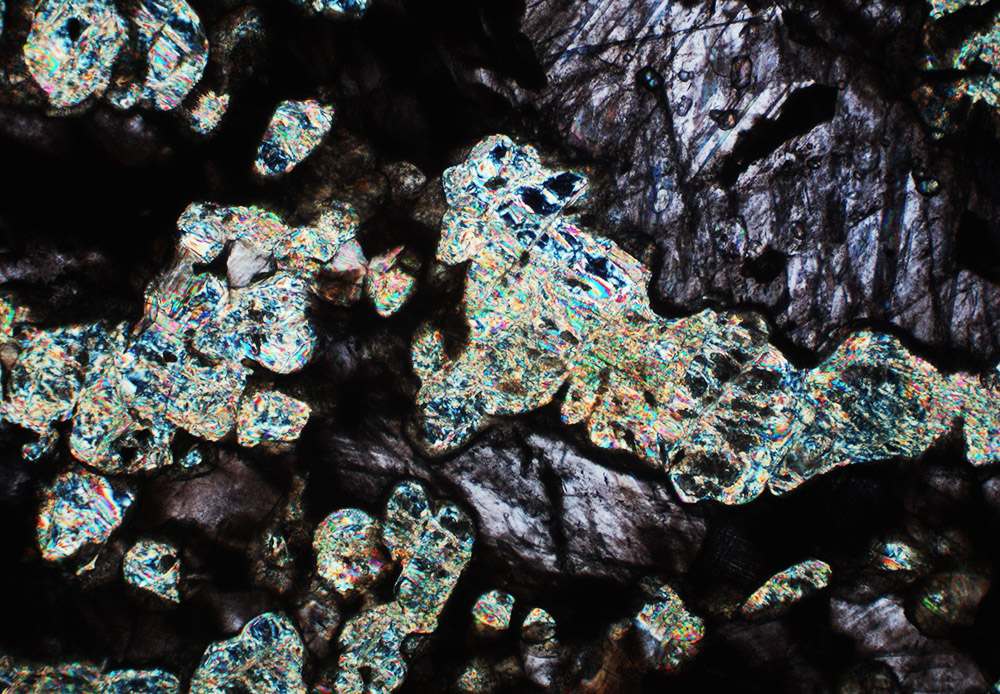
Figure 2.
Photomicrograph of Eozoon, as prepared by J.B. Jordan. Photographed with a 3.5x objective lens, transmitted light, and crossed polarized filters, with a C-mounted digital SLR camera on a Leitz Ortholux II microscope.
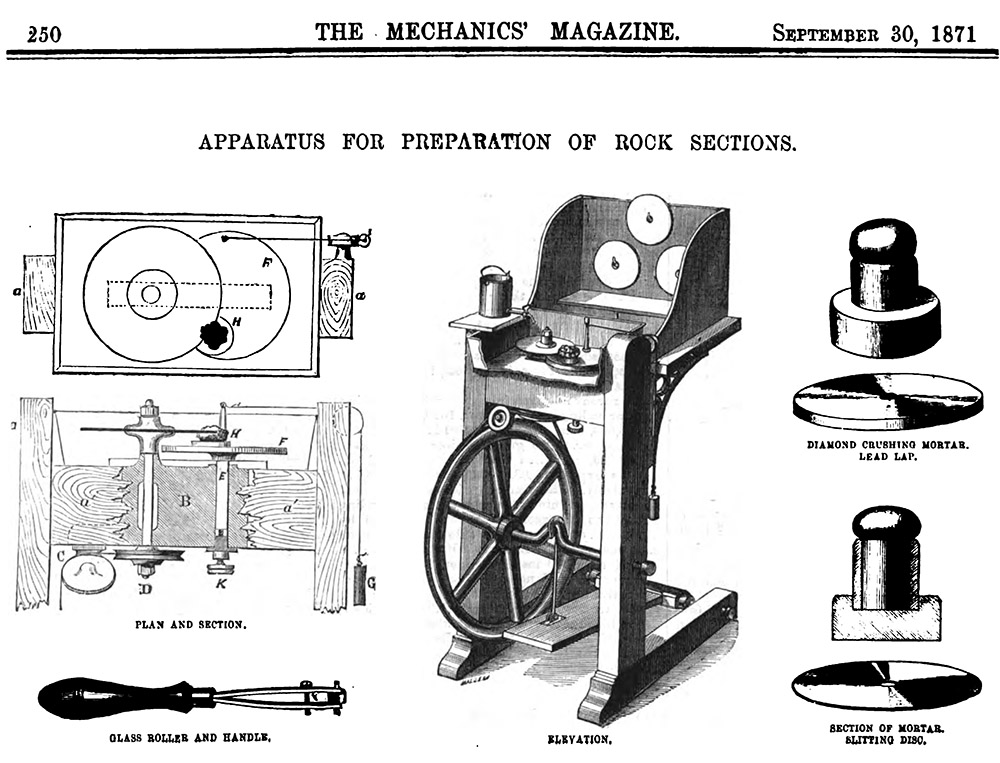
Figure 3.
Images that accompanied an 1871 article on Jordan's rock cutting and grinding machine. It was later described, "This consists of a mahogany framework similar to that of an ordinary lathe, and is supplied with crank, heavy fly-wheel about 24 in. diameter and treadle occupying a floor space of 24 in. by 15 in. To the bed of this frame is fitted an iron casting bored to receive two spindles, viz., a vertical spindle which carries the slitting disc, grinding laps, &c., and another spindle to which is fixed a horizontal plate carrying on its surface a cup containing cement into which the material to be cut is embedded, and which is retained and uniformly pressed against the slitting disc by means of a cord attached to the plate near its edge, which, passing over a pulley, supports a weight which gives a constant and regular pressure. This plate can be raised or lowered as required by means of a screw below the bearing. Horizontal motion is given to the slitting disc by means of two obliquely-set wheels below the bearing, over which the cord passes to a horizontal wheel. When the machine is required for grinding, &c., the slitting disc is removed and the laps, of which three are provided, are fixed in its place. The whole of the upper part is underlaid by a zinc tray, perforated in the centre for the axles. At the side, on a movable ledge, stands a water vessel with tap, by which the disc or lap can be kept perpetually moistened".
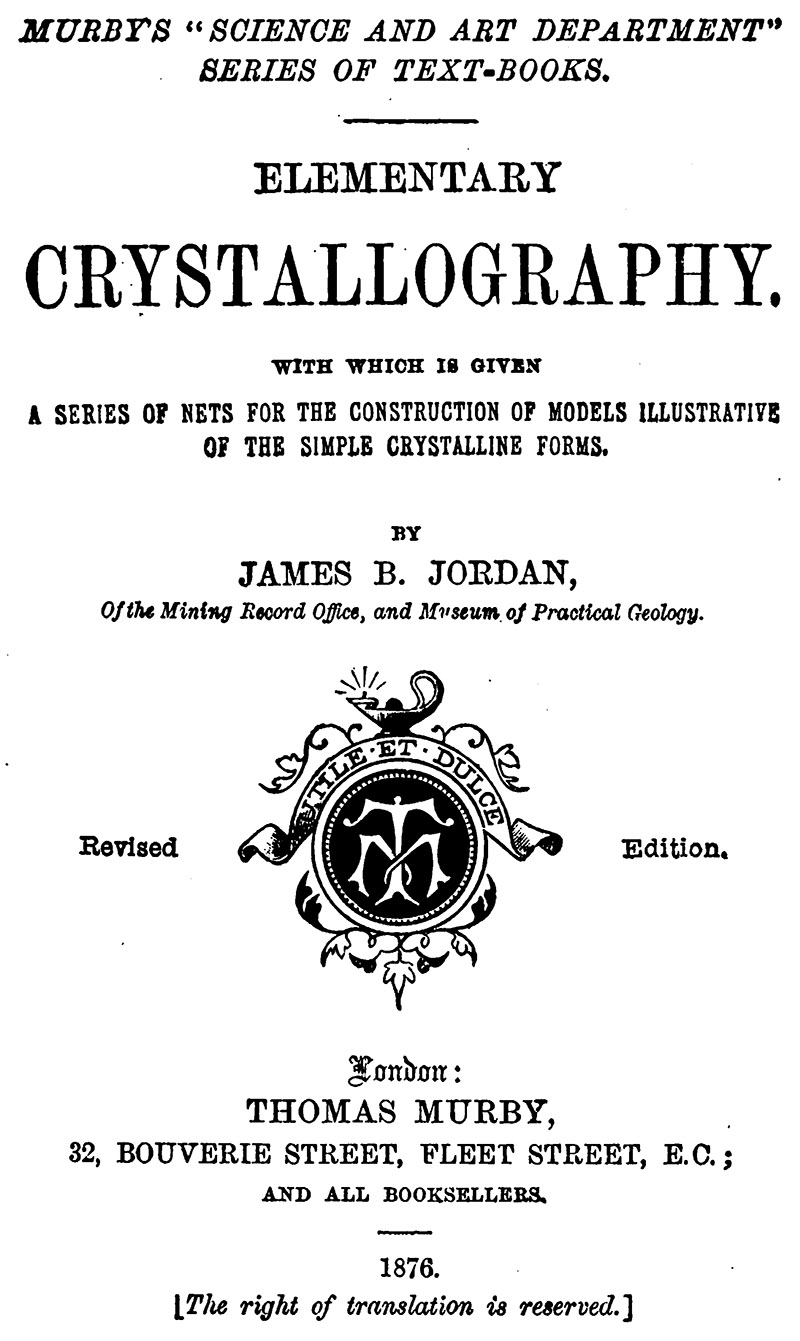
Figure 4.
Title page from J.B. Jordan's "Elementary Crystalography", revised edition, 1876.
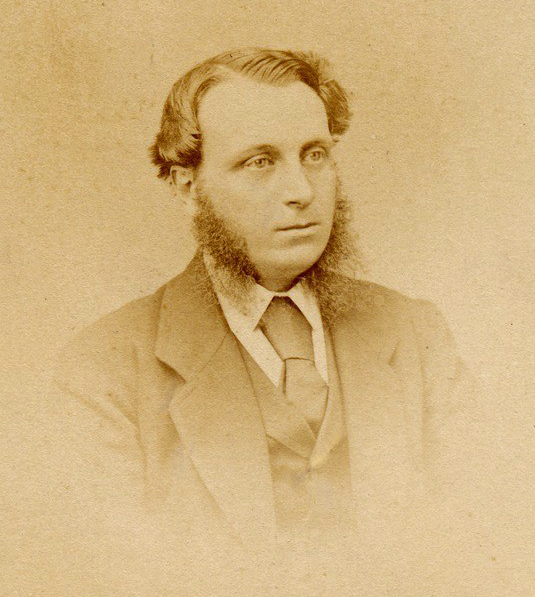
Figure 5.
An undated photograph of James Brown Jordan, adapted for nonprofit, educational purposes from http://earthwise.bgs.ac.uk/index.php/James_B._Jordan .
James Brown Jordan was born on August 31, 1838, in Falmouth, Cornwall. He was the first child of Thomas Brown and Sarah Jordan. The father was a well-known mining and mechanical engineer, whose entry in The Dictionary of National Biography includes:
"Jordan, Thomas Brown (1807-1890) … began life as an artist. When barely twenty he migrated to Falmouth. While painting there and at Penzance he made the acquaintance of Robert Were Fox, in whose physical researches he took the greatest interest. Fox's influence led him to relinquish painting and to set up as a mathematical instrument maker in Falmouth, where he effected improvements in the miners' dial, and had some share in the construction of Fox's improved dipping-needle. In 1838 Jordan devised an instrument for recording by photography the variations of the barometric column, and he shortly afterwards invented a declination magnetograph and a self-recording actinometer. For some years subsequent to 1839 he held the post of secretary of the Royal Cornwall Polytechnic. Sir Henry de la Beche, when engaged on the geological survey of Cornwall, made Jordan's acquaintance, and secured his appointment in 1840 as first keeper of mining records, with charge of plans, sections, and models. Jordan took a great interest in electro-metallurgy during the early years of its development, and in 1841 he made an egg-cup of electro-deposited copper, plated with silver outside and gold inside, which was considered a model of workmanship, and is now deposited in the Museum of Practical Geology, Jermyn Street, London. On resigning his appointment as keeper of mining records in 1845, Jordan invented a highly ingenious process of carving by machinery, and set up works at Lambeth for carrying into effect the invention, for which in 1847 he received the gold Isis medal from the Society of Arts. The wood-carving machinery was subsequently exhibited at the Great Exhibition of 1851, and the products were extensively used in the decoration of the House of Lords. Later on Jordan started work as a mechanical engineer, first at Manchester, then at Glasgow, where he devised a series of machines for the production of school slates. Shortly after 1870, however, he returned to London, and established himself as a mining engineer in conjunction with his son, Mr. Thomas Rowland Jordan, who still conducts the business. Jordan's last invention, patented in 1877, was a portable machine for boring blast-holes in rock. He died in London on 30 May 1890".
Another history highlighted his wood carving machines (Figures 6 and 7), "In 1845 invented and patented a machine for carving wood ... Jordan’s patent allowed for up to eight copies to be made simultaneously. The machinery was extensively used for carving at the new Palace of Westminster. The firm was official known as Taylor, Williams and Jordan, operating from the former Coade and Sealy terracotta works in Belvedere Road, Lambeth, as well as from Thames Bank (for the Palace of Westminster work) and Long Acre. An advertisement placed in The Builder, March 1847 put Jordan’s patent competitively alongside Irving’s and another placed by the ‘Patent Wood Carving Offices’. The Jordan’s advert highlighted the firm’s work at the Palace of Westminster and quoted a review from The Athenaeum which deemed the carving ‘worthy to hang by the side of Grinling Gibbons’s Works…The Machinery employed accomplishes precisely the task assigned to the Sculptors assistant. It clears away all superfluities and prepares the object for the final touches of the Artist. No matter how high the relief or how low or intricate the undercutting, - no difficulties baffle this machinery’. In 1847 Jordan was awarded the Gold Medal by the Royal Society of Arts and in the Medieval Court at the Great Exhibition of 1851 the firm displayed a large Gothic screen illustrating dead game and foliage, as a specimen of machine carving. By 1852 the Lambeth factory employed one hundred hands. Despite apparent success, in 1855 the stock in trade and machinery was advertised for sale and was bought by Cox & Son, ecclesiastical furnishers".
Thomas Jordan's inventions and business made him a fairly wealthy man. For example, the 1851 census shows the Jordan household, now numbering 6 children, being attended by two domestic servants, while young James was enrolled in a boarding school in Sussex.
On completing school, James took work with his father's old employer, the Museum of Practical Geology. He remained with government geological offices until he retired in about 1900. Jordan's job included production of three-dimensional models of mining machinery and geological formations, and drawing detailed geological maps.
James married Sarah Susannah Phillips in the spring of 1864. They had one child, a son.
In 1865, Jordan published Explanatory Remarks on the Construction and Use of a Series of Models illustrating the Simple Forms of Crystallography, a 32-page book of patterns for constructing 41 different crystal models from cardboard.
An 1867 description of the Museum of Practical Geology included thus description of a water barometer that was made by Jordan, "This instrument has recently been erected at the northern end of the room, near Wall-case 29. From the ordinary mercurial barometer it differs only in the substitution of a column of water for one of quicksilver; but since water is, bulk for bulk, about 13 1/2 times lighter than quicksilver, it is obvious that the column of water necessary to counterbalance the atmospheric pressure must be 13 1/2 times longer than that used in our ordinary instruments; thus, the mean height of the mercurial barometer being about 30 inches, that of the water barometer will be upwards of 33 feet. Apart from other objections, the manifest inconvenience of so unwieldly an instrument forbids its general adoption, but the extreme sensibility of its indications gives it considerable scientific interest; the column of water being sensibly affected by variations in aerial pressure too slight to produce any perceptible effect on the mercurial barometer. In the instrument before us, which was constructed by Mr. J.B. Jordan on the plan suggested by Mr. Bird of Birmingham, the glass tube forming the upper part of the barometer is alone exposed, the metal tubing constituting the lower portion being carried downwards to the basement of the building, where it terminates in a cistern of water, the surface of which is covered with a stratum of mineral oil to prevent evaporation of the liquid and absorption of air". Jordan later developed a glycerine barometer, and published its details in Proceedings of the Royal Society in 1873.
Jordan was elected to membership in the Quekett Microscopical Club on December 18, 1868. On February 26, 1869, he exhibited "sections of crystallised rocks" and gave a talk "On an improved apparatus for the preparation of rock sections for microscopical examination". He began his presentation, "To describe with accuracy the mineral composition of a given rock is often a task of considerable difficulty, especially if the individual minerals occur only in minute crystals or in granular masses, and are so intimately associated as to show to the naked eye only a fine grained appearance. Such rocks nevertheless frequently fall under the notice of the geologist, who of course gladly avails himself of any aid - whether chemical, physical, or mechanical - which may assist him in his examination. Among these aids there is none more important than that offered by the microscope. By studying sections of sufficient thinness to admit of examination by transmitted light, considerable insight is gained as to the character of the component minerals of the rock and their mode of association; whilst the value of such observations may be increased by introducing the use of polarized light…Having had occasion to cut and grind a series of geological specimens of rocks, fossils, and other mineral structures, I could not find that there was any machine to be purchased suitable for the purpose; I was therefore led to design an apparatus for myself, which I have had in operation for about twelve months". At the 1870 QMC Soiree, Jordan "exhibited his apparatus for cutting thin sections of Rocks and other hard substances, with specimens of rock sections prepared therewith". His membership lapsed during 1873.
Around 1870, Jordan entered into a contract with Cotton and Johnson, a machinery manufacturing company in Soho, who produced and sold his rock cutting machine for several decades.
Several publications from the early 1870s thanked "Mr. J.B. Jordan, of the Mining Record Office" for production of thin sectioned rocks. It is not clear whether these slides were prepared as part of his employment, or if he made slides as a side business. The eozoon preparation shown in Figures 1 and 2 probably dates from this time period.
James' wife, Sarah, died in 1889. He remarried, to Joanna Glassford, in 1893. He retired in about 1900, and the couple moved to Hythe, Kent. James Jordan died on December 1, 1915, while on holiday in Torquay, Devonshire.
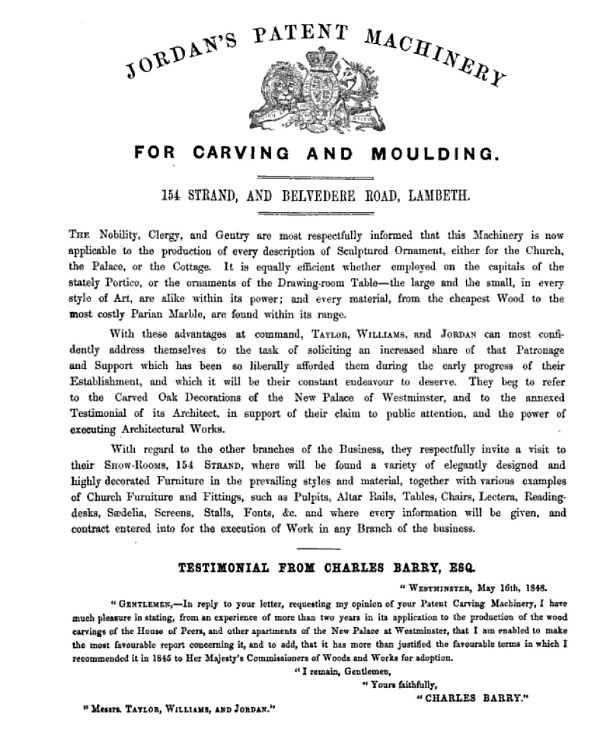
Figure 6.
An 1848 advertisement for J.B. Jordan's father's machine carving works. Adapted for nonprofit, educational purposes from http://vintagemachinery.org/mfgindex/imagedetail.aspx?id=21905
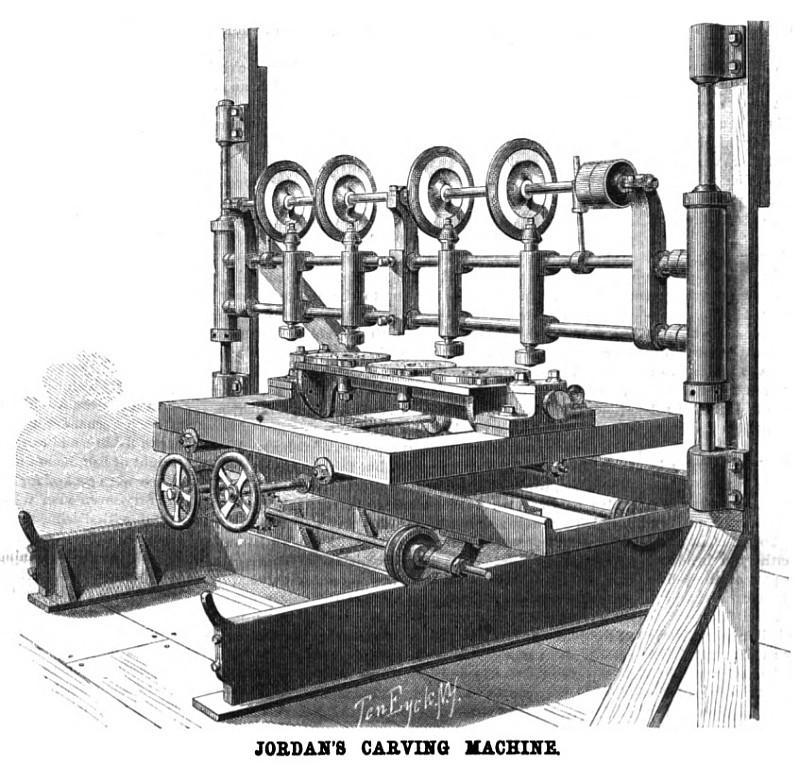
Figure 7.
One of Thomas Jordan's machine carving tools, from an 1871 article in "Scientific American". His father's mechanical inclinations undoubtedly facilitated J.B. Jordan's invention of his rock slicing/grinding machines. Image adapted for nonprofit, educational purposes from http://vintagemachinery.org/mfgindex/imagedetail.aspx?id=21904
Resources
Adye, E. Howard (1905) Cutting, grinding, and mounting rock sections, Technics, Vol. 3, pages 129-135
BIFMO Project (accessed August, 2021) "Jordan, Thomas, Jordan & Co.", Furniture History Society, https://bifmo.history.ac.uk/entry/jordan-thomas-1845-1855
Catalogue of the Science Collections for Teaching and Research in the South Kensington Museum (1892) 70. Amateur's lapidary machine for slitting, grinding, and polishing. Designed by J.B. Jordan, page 25
Ellis, William (1886) Brief historical account of the barometer, Quarterly Journal of the Royal Meteorological Society, Vol. 12, pages 131-171
England census and other records, accessed through ancestry.com
Hull, Edward (1873) Observations on the microscopic structure of Irish granites, Geological Magazine, Vol. 10, pages 193-196 ("The slices were prepared by Mr. J.B. Jordan, of the Mining Record Office")
Hull, Edward (1875) On the Microscopical Structure of Red Quartz-Porphyry, from the Old Red Sandstone of Logan Water, above Lesmahagow, Transactions of the Geological Society of Glasgow, Vol. 5, pages 25-28
Hunt, R., and F.W. Rudler (1867) A Descriptive Guide to the Museum of Practical Geology, With Notices of the Geological Survey of the United Kingdom, The Royal School of Mines, and the Mining Record Office, Third Edition, HM Printing Office, London, pages 2, 126, and 128
Jordan, James B. (1865) Explanatory Remarks on the Construction and Use of a Series of Models illustrating the Simple Forms of Crystallography, Stanford, London
Jordan, James B. (1869) On an improved apparatus for the preparation of rock sections for microscopical examination, Journal of the Quekett Microscopical Club, Vol. 1, pages 186-189
Jordan, J.B. (1870) Stanford's Geological Map of London shewing the Superficial Deposits, Stanford, London
Jordan, James B. (1873) Elementary Crystallography, With Which is Given a Series of Nets for the Construction of Models Illustrative of the Simple Crystalline Forms, Thomas Murby, London
Jordan, James B. (1873) On the construction of a glycerine barometer, Proceedings of the Royal Society, Vol. 30, page 105
Jordan, James B. (1876) Elementary Crystallography, With Which is Given a Series of Nets for the Construction of Models Illustrative of the Simple Crystalline Forms, Revised Edition, Thomas Murby, London
Jordan, J.B. (1878) Stanford's Geological Map of London and its Suburbs, Stanford, London
Jordan, J.B. (1879) A Geological Section Shewing the Order of Superposition and Approximate Maximum Thickness of Sedimentary Strata in the British Islands, Stanford, London
Jordan, J.B. (1881) The Glycerine Barometer: With Plate and Table of Corrections for Temperature, Stanford, London
Jordan, J.B. (1894) Map of the British Isles Shewing the Districts Assigned to Her Majesty's Inspectors of Mines, Her Majesty's Stationery Office, London
Journal of the Quekett Microscopical Club (1868) Minutes of the November 27 and December 18 meetings, Vol. 1, pages 148-178
Journal of the Quekett Microscopical Club (1869) Minutes of the February 26 meeting, Vol. 1, pages 180 and 182
Journal of the Quekett Microscopical Club (1870) Annual Soiree, Vol. 2, pages 57-60
Journal of the Quekett Microscopical Club (1872) Members: "Dec. 18, 1868, Jordan, James B., 11 Grafton-sq., Clapham, S.W."
Journal of the Quekett Microscopical Club (1873) Members: "Dec. 18, 1868, Jordan, James B., 11 Grafton-sq., Clapham, S.W."
Journal of the Quekett Microscopical Club (1874) Members: J.B. Jordan not listed
Mechanics' Magazine (1871) An improved apparatus for the preparation of rock sections for microscopical examination, page 250
Probate of the will of James B. Jordan (1915) "Jordan James Brown of Hayfield Hillcrest-road Hythe Kent died 1 December 1915 at Falkland House Torquay Devonshire Probate London 7 January to Joanna Ann Gilkison Jordan widow. Effects £235 1s 3d", accessed through ancestry.com
Seccombe, Thomas (1900) "Jordan, Thomas Brown", Dictionary of National Biography, Vol. 30, page 200






